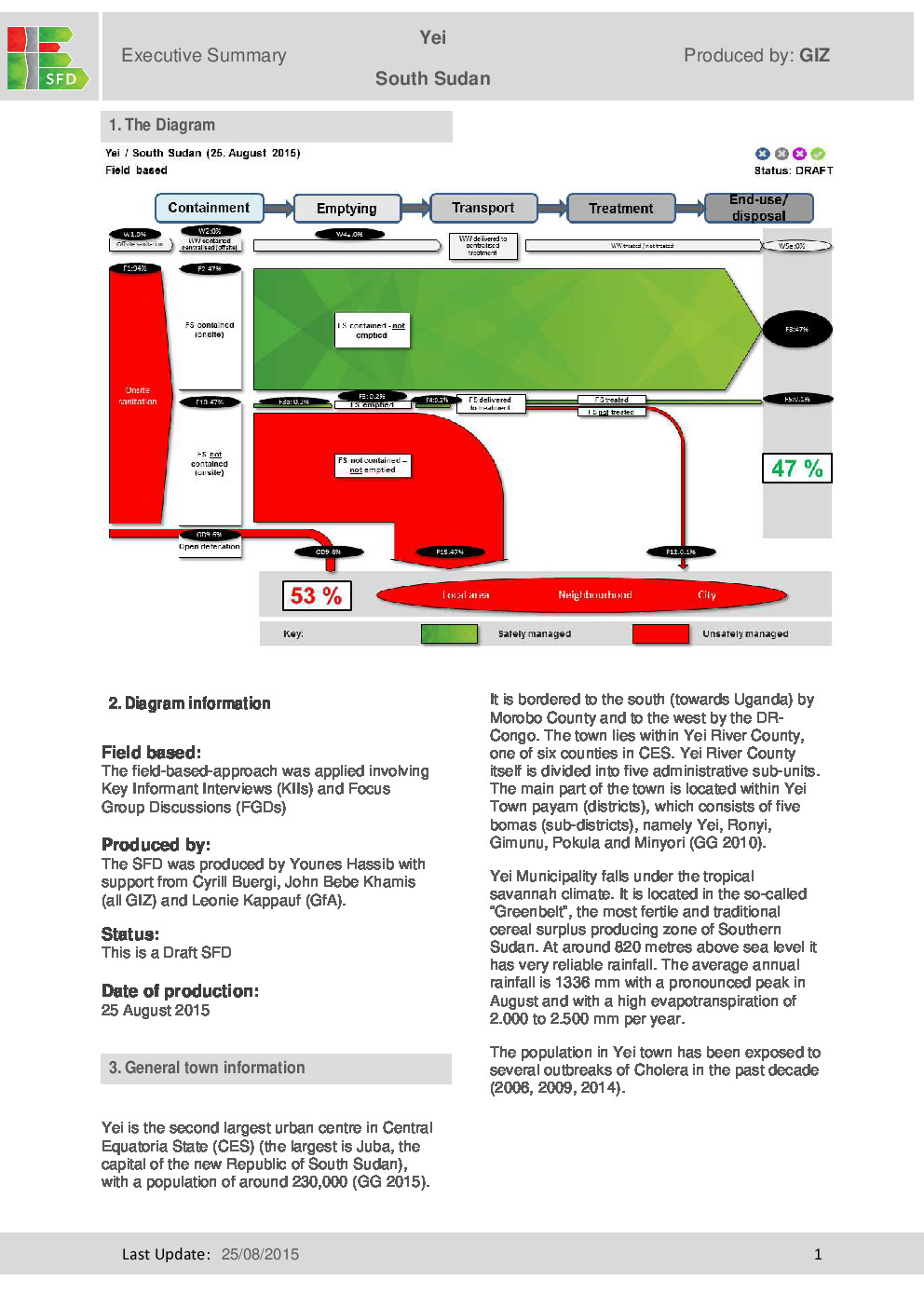-
Containment Collection and transport Treatment Disposal / Reuse
-
Capacity building Finance Information Education and Communication / Behavior Change Communication Infrastructure Policy and processes Technology
-
Access to sanitary toilets Better governance and planning Change in disease burden Collection efficiency of sanitation system Cost recovery Environmental sustainability through reuse, resource recovery, conservation Equity and social inclusion Private sector engagement Quantity of waste safely treated Sanitation practices of the supply side Sanitation practices of the end user
-
SFD Report - Khulna, Bangladesh - SFD Promotion Initiative
Khulna is located in the south-western part of Bangladesh, with a population of 1.5 million and a total area of 46 km2. Its National policy and strategy documents encourage both NGOs and the private sector to actively engage in providing sanitation services. However, the SFD assessment has shown that 100% of the excreta in Khulna is not contained and therefore unsafely managed.The Shit Flow Diagram (SFD) was created through field-based research by Sandec (Sanitation, Water and Solid Waste forDevelopment) of Eawag (the Swiss Federal Institute of Aquatic Science and Technology) with the support of SNV Netherlands Development Organisation, Khulna University of Engineering and Technology (KUET) and Khulna University.Date of production: 11/11/2015Last update: 17/12/2015
-
SFD Report - Kisumu City, Kenya - SFD Promotion Initiative
Kisumu is the principal city of western Kenya and the third largest city in Kenya. It covers an approximate area of 297 km2 and sits on the shores of Lake Victoria. The city is divided into two topographical areas, the hilly north and the southern plain. The current population is estimated to be 419,072 and 60% of the population live in informal settlements. A majority of people in Kisumu use unlined pit latrines (66%). A majority of these pits are manually emptied and the faecal sludge is then discharged into the local environment without treatment. 20% of the excreta from the population of Kisumu is discharge directly to sewers, 80% of this stream reaches one of the two sewage treatment plants where it is treated. 9% of the populations’ excreta in contained in improved pit latrines, sealed or septic tanks. These are emptied by vacuum tankers and the faecal sludge is then taken to Nyalenda Sewage Treatment Plant. Currently 33% of the excreta produced by the population of Kisumu is considered to be safely managed.
-
SFD Report - Moshi, Tanzania - SFD Promotion Initiative
Moshi municipality is an administrative district in Kilimanjaro province whose population has growth from less than 10,000 to 185, 000 residents. The majority of households depend on on-site sanitation which is poorly documented, not regulated or monitored. In Moshi it was estimated that 36% of excreta is managed safely while 64% of the excreta ends up directly in the environment without adequate treatment.This Shit Flow Diagram (SFD) Report was created through field-based research by GIZ as part of the SFD Promotion Initiative.Date of production: 25/11/2015Last update: 08/03/2016
-
SFD Report - Nashik, India - SFD Promotion Initiative
The city of Nashik is located in the northwest of the state of Maharashtra in the Western Ghats at the source of the Godavari River. As per Census 2011 Nashik has a total population of just under 1.5 Million. In Nashik it was estimated that 85% of excreta is managed safely while 15% of the excreta ends up directly in the environment without adequate treatment.This Shit Flow Diagram (SFD) Report was created through field-based research by GIZ as part of the SFD Promotion Initiative.Date of production: 10/11/2015Last update: 08/03/2016
-
SFD Report - Nonthaburi, Thailand - SFD Promotion Initiative
Nonthaburi City Municipality is the principal city of Nonthaburi province, located to the north of Bangkok. It has a registered population of 256,457 in the area of 38.9 km2 (NCM 2015a). Most of the houses have onsite sanitation systems such as septic tanks or cesspools. The city municipality is responsible for the collection, transportation and treatment of the generated faecal sludge according with the Public Health Act 1992; resulting in 79% of excreta flow safely managed. The Shit Flow Diagram (SFD) was created through desk-based research by Sandec (Sanitation, Water and Solid Waste for Development) of Eawag (the Swiss Federal Institute of Aquatic Science and Technology) with the support of the Kyoto University, Japan, the Asian Institute of Technology, Thailand and the Mahidol University, Thailand.Date of production: 11/11/2015Last update: 16/12/2015
-
SFD Report - Solapur, India - SFD Promotion Initiative
Solapur is located on the south-eastern border of Maharashtra State. The population of the city is 951,118 persons. One-fifth of city’s population depends on public toilets while septic tanks and pits are most common in Solapur’s households. There is a sewerage network but it covers less than half of the population.Date of production: 01/08/2015Last update: 07/01/2016
-
SFD Report - Solapur, India - SFD Promotion Initiative
Solapur is located on the south-eastern border of Maharashtra State. The population of the city is 951,118 persons. One-fifth of city’s population depends on public toilets while septic tanks and pits are most common in Solapur’s households. There is a sewerage network but it covers less than half of the population.Date of production: 01/08/2015Last update: 07/01/2016
-
SFD Report - Tiruchirappalli, India - SFD Promotion Initiative
Tiruchirappalli, also known as Trichy, is one of the largest cities in Tamil Nadu and is known as an important trade, education and pilgrimage centre. The population of city as per the 2011 Census is 916,857. There is sewerage network which covers 59% of the population. Rest of the city is majorly dependent on septic tanks which are generally not adhering to design prescribed by Bureau of Indian Standards (BIS).Date of production: 26/09/2015Last update: 19/02/2016
-
SFD Report - Tumkur, India - SFD Promotion Initiative
Tumkur (also known as Tumakuru) is located along the Pune-Bangalore National Highway N°4. The sewerage network covers half of the population, but there is also a high dependence on septic tanks, without the correct design, and pits. Tumkur possesses a Sewage Treatment Plant but has no treatment facilities for septage.This SFD Report was created through desk-based research by Centre for Science and Environment (CSE) as part of the SFD Promotion Initiative. Executive summary: 03/08/2015 (Last update: 25/08/2015)Final report: 03/08/2015 (Last update: 30/12/2015)
-
SFD Report - Tumkur, India - SFD Promotion Initiative
Tumkur (also known as Tumakuru) is located along the Pune-Bangalore National Highway N°4. The sewerage network covers half of the population, but there is also a high dependence on septic tanks, without the correct design, and pits. Tumkur possesses a Sewage Treatment Plant but has no treatment facilities for septage.This SFD Report was created through desk-based research by Centre for Science and Environment (CSE) as part of the SFD Promotion Initiative. Executive summary: 03/08/2015 (Last update: 25/08/2015)Final report: 03/08/2015 (Last update: 30/12/2015)
-
SFD Report - Yei, South Sudan - SFD Promotion Initiative
Providing water and sanitation to Yei population is one of the concerns of the government, considering that around 60% of the households use pit latrines with minimal stability, mud floor and low privacy (whose management is affecting groundwater quality).; less than 1% of population have a septic tank and emptying contamination facilities is practiced by only 7% of the households.This SFD Report was created through field-based research by Deutsche Gesellschaft für Internationale Zusammenarbeit (GIZ) as part of the SFD Promotion Initiative. Executive summary: 25/08/2015 (Last update: 25/08/2015) Final Report: 25/11/2015 (Last update: 08/03/2016)
-
SFD Report - Yei, South Sudan - SFD Promotion Initiative
Providing water and sanitation to Yei population is one of the concerns of the government, considering that around 60% of the households use pit latrines with minimal stability, mud floor and low privacy (whose management is affecting groundwater quality).; less than 1% of population have a septic tank and emptying contamination facilities is practiced by only 7% of the households.This SFD Report was created through field-based research by Deutsche Gesellschaft für Internationale Zusammenarbeit (GIZ) as part of the SFD Promotion Initiative. Executive summary: 25/08/2015 (Last update: 25/08/2015) Final Report: 25/11/2015 (Last update: 08/03/2016)















